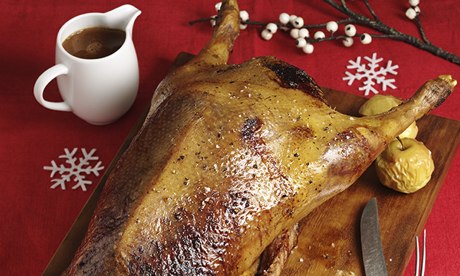
Goose is one of the most delicious birds. But goose is tricky. It doesn't cook like a duck, nor a chicken. You can't cook it too little, because rare won't do it any good. If it's not cooked enough, it can be tough as leather. And you can't cook it too much, because it must have a little pink to it. It needs to cook to what I would call a pink well-done. Here's what to do.
Get the goose (a 5-7kg bird is the most common) five days before Christmas. Bring it home and clean it for excess fat. There's probably going to be quite a bit – if it's a good goose, probably 1-2kg of extra fat from the rump and insides. If you're smart, you'll save that excess fat. Render it down and keep it in a jar so you can spread it on freshly baked bread later. It's a mouthful from the gods.
Remove the offal and continue to clean and trim. If you have enough space, let the cleaned and trimmed bird hang in your fridge. This will dry up the skin, rendering it crispier during cooking, and water content will evaporate from the meat, concentrating flavors. When Christmas Day arrives, take out the bird and leave it out until it's at room temperature.
Stuffing the goose is important if you want juicy breast meat. The traditional Danish way is with quartered apples – really tart ones – and pitted prunes. Stuff the bird until it looks as if it's about to burst. By this time, you should have heated your oven to 250C/gas mark 9. Place the bird in a semi-deep roasting pan and chuck it in there. The pan's also crucial, because lots of fat drips off during the cooking. Brown the bird for about 20 minutes at this temperature. Take it out quickly, bring the oven down to 175 C/gas mark 4, and if you can, pour out all the goose fat that's now in your roasting pan. If that doesn't work for you, then use a ladle. Mix the fat from the pan with the rendered goose fat from before and roast the bird for 2-2½ hours (depending on the size – if it's 7kg, I do it for 2½). Add the offal to the pan for added flavour to the sauce later. It's crucial to add half a litre of water to the pan the second time it goes in the oven. Keep an eye on this. If it evaporates too much, add another half-litre. After the 2 or 2½ hours, remove the bird from the oven and let it rest for a good 30 minutes.
• In Denmark, everyone tends to serve goose with red cabbage. I don't like that. Christmas is the one time of year I get to eat goose, so please, let it be the main attraction. If you want a little extra, though, mix the goose fat and sauce from the pan with cream and then add some sauce colouring to make it nice and dark. Food colouring may be out of fashion in some corners of the world, but it's not a classic Danish Christmas without it.

